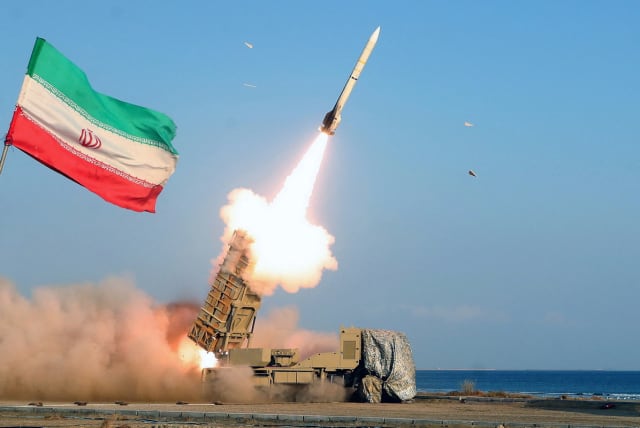Uranium, missiles or weaponization: Where does Iran go from here? - analysis

Iran is now approaching a kind of “what’s next” issue. Where does it go from here? Let’s look at the recent news.
Iran is continuing to enrich uranium, which means that it is likely moving beyond the 84% mark – and could soon reach up to 90%. Iran Watch, a website published by the Wisconsin Project on Nuclear Arms Control, noted last year that “Iran’s centrifuges have not produced uranium usually defined as weapon-grade, which is uranium enriched to 90% in the isotope U-235. All of Iran’s production has been at lower grades.” So, where does Tehran go from here?
Over the weekend, CIA director William Burns told CBS News in an exclusive interview that, “to the best of our knowledge, we don’t believe that the Supreme Leader in Iran has yet made a decision to resume the weaponization program that we judge that they suspended or stopped at the end of 2003… the other two legs of the stool, meaning enrichment programs, they’ve obviously advanced very far.” He also mentioned the Iranian missile program and Iran nearing the “threshold” of becoming a nuclear state.
A report over the weekend noted that CIA director William Burns told CBS News in an exclusive interview that “to the best of our knowledge, we don't believe that the [Iran] Supreme Leader in Iran has yet made a decision to resume the weaponization program that we judge that they suspended or stopped at the end of 2003…the other two legs of the stool, meaning enrichment programs, they've obviously advanced very far." He also mentioned the Iranian missile program and Iran nearing the “threshold” of becoming a nuclear state.
The report said Iran “has not resumed weaponization.”
The triangle of weaponization
We need to think of enrichment, weaponization and missile delivery for a bomb as three sides of the triangular base of a pyramid, the top point of which being a nuclear armed state that can fire or deliver a weapon at a long range and strike anywhere in the region or beyond.
If we think of the nuclear pyramid in this way, it becomes clear that one leg is now almost fully constructed – 90% enrichment. The missile program continues as well; Iran has numerous ballistic missiles and also satellite launch vehicles.
What about the actual bomb, the weapon? Iran Watch noted that “the analysis above assumes that Iran would use 16 kg. of highly enriched uranium metal (about 90% U-235) in the finished core of each nuclear weapon. The amount of 16 kg. is assumed to be sufficient for an implosion weapon. This was the amount called for in a design for such a device that has circulated on the nuclear black market, to which Iran has had access.”
Iran’s nuclear program is one of those interesting puzzles that the late former US secretary of defense Donald Rumsfeld would have appreciated. There are known knowns, unknown knowns, known unknowns, and unknown unknowns relating to the nuclear program.
We know that Iran has enriched up to around 84%. We know Tehran has long range missiles. But do we know how far it has gotten in terms of thinking about making an actual nuclear device to test – something similar to Fat Man or Little Boy the US made in 1945 or the type tested in China in the 1960s, or in Pakistan in the 1990s or in North Korea in 2017?
Iran must decide its next steps
There are many options and models for Iran to pursue. Some are more relevant and some are less relevant. This isn’t the 1940s; Iran can’t build long-range bomber aircraft for a nuclear weapon.
This means that Iran must decide what to do next. It appears preferable for Tehran to continue developing a delivery system, such as perfecting its missiles, because it can cover this with claims it is merely building long-range missiles. Trying to weaponize the uranium with an actual test bomb would be complex, take time and also lead to major tensions.
Iran must also consult with China and Russia about what comes next. It can’t afford to do something that will anger its friends in Beijing and Moscow, who don’t care if Tehran builds more missiles, but may care if it takes risks by trying to create some kind of test weapon.
Iran now begins to move down new tracks where it will have to make key decisions soon. These decisions will impact how it wants to continue to build up its nuclear pyramid – or if it even wants to continue to build at all.
Jerusalem Post Store
`; document.getElementById("linkPremium").innerHTML = cont; var divWithLink = document.getElementById("premium-link"); if (divWithLink !== null && divWithLink !== 'undefined') { divWithLink.style.border = "solid 1px #cb0f3e"; divWithLink.style.textAlign = "center"; divWithLink.style.marginBottom = "15px"; divWithLink.style.marginTop = "15px"; divWithLink.style.width = "100%"; divWithLink.style.backgroundColor = "#122952"; divWithLink.style.color = "#ffffff"; divWithLink.style.lineHeight = "1.5"; } } (function (v, i) { });
